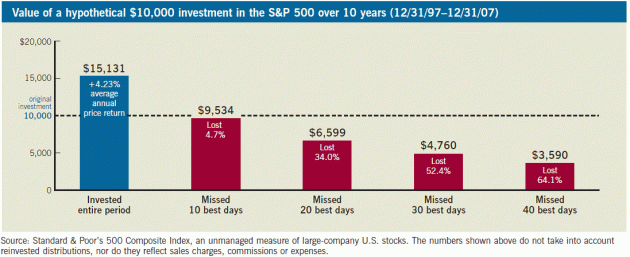Continued from Part I.
If the crowds of investors were not all that wise during the recent market cycle what is another possible explanation for the behavior driving the markets?
Herd Mentality is used to describe how people and businesses are influenced by those around them when making decisions. People may act in conjunction with the herd simply because they are influenced by those around them, there is comfort in sticking to the status quo or they are afraid on missing out on what everyone else is experiencing.
Alan Greenspan, the former Chairman of the Federal Reserve, in a Financial Executive article summarized banks willingness to follow the herd in the following way;
“One difficult problem is that much of the dubious financial market behavior that chronically emerges during the expansion phase is the result not of ignorance but of the concern that unless firms participate in a current euphoria, they will irretrievably lose market share.”[1]
Another executive put it more succinctly saying, “No one ever made money by sitting out a boom.” [2]
In his January 2008 article Michael Carroll suggests the financial sector was caught in a “Thundering Herd Mentality.”[3] In a rush to keep up with competitors, institutions were anxious to follow their competition into the subprime lending and structure credit markets. While this strategy worked in the short-term, creating record profits, it has since backfired colossally. The bubble in the house prices could not be maintained forever and when these prices collapsed banks’ fortunes did as well.
How were these ultimately disastrous decisions allowed to be made? Bowditch and Buono suggest groupthink fosters three illusions that lead to poor decision making. The most relevant to the current situation is the illusion of invulnerability. This “leads to over-optimism and encourages high risk taking by group members.[4]
I think this illusion of invulnerability coupled with a rush to keep pace with competitors is largely to blame for the current situation of banks and the market in general. The short-term success and profit turned out by some in the industry lead the other financial institutions to throw themselves headlong into subprime lending and structure credit markets so as to not miss out on what was viewed as a once in a generation profit opportunity.
So if there is evidence of groupthink in the market and our financial intuitions and they are not completely efficient long-term as wisdom of crowds would suggest what can be done. What can be done to protect a portfolio from massive market downturns?
John Maynard Keynes, the 20th century British economist whose economic theory revolved around demand-side actions as a framework to conduct economic policy, famously said “The market can stay irrational longer than you can stay solvent.” Contrarian views may eventually prove correct but may be a long timing in coming. An example of this would be M. King Hubbert, a geophysics, who in 1956 predicted that U.S. oil production would peak in 1970.[5] He was ridiculed at the time of the prediction but this and his other predictions about worldwide oil production have proved to be accurate.
Gary Shilling, the Stanford Ph.D. in economics who invests $100 million dollars for clients, predicted a collapse in housing prices in 2004.[6] He was a little early but the prediction proved true. Predicting timing is nearly impossible but I believe the long term trends can be spotted. Research shows that even missing the 10 best days of the market has a dramatic effect on investment returns. Over a ten year period if you missed the 10 worst days in the S&P your return would swing from a 4.23% annual gain to a 4.7% loss (8.9% total difference). See chart 3. This is missing 10 days out of 2,515 or .4% of all days.[7] It would be nearly impossible to correctly predict when these 10 days would occur. Another study showed that from 1900 – 2008 only missing the 10 best days, 2/3 of the cumulative gains in the Dow would be erased.[8] Ten days out of 29,694 had that big of an affect on returns!
This goes to show the difficulty of picking any one of the best days in the market but I don’t think it rules out the possibility of predicting long term periods when the market is over valued or under valued.
I think that while the market may behave efficiently in the short term there are long term trends that can be spotted. Using Shiller’s P/E10, the Monthly Housing Affordability Index[9] and other macro indicators I believe it is possible to spot times when long term investments have either favorable or unfavorable tailwinds. A portfolio can then be adjusted as more aggressive or defensive based on these views. The key is independent thinking based on data and not getting caught up with the herd.
[1] Marshall, Jeffrey. “Lessons from the Abyss.”
Financial Executive; May 2008, Vol. 24 Issue 4, 36-43.
[2] Marshall, Jeffrey. “Lessons from the Abyss.” Financial Executive; May 2008, Vol. 24 Issue 4, 36-43.
[3] Carroll, Michael. “Thundering Herd Mentality.” Institutional Investor; Jan 2008, Vol. 42 Issue 1, p5-5.
[4] Bowditch, James L. and Anthony F. Buono. A Primer on Organizational Behavior. New York: John Wiley & Sons, c2005
[5] K. Deffeyes. “Hubbert’s Peak in the 21st Century.” Princeton University. Accesses 17 Mar. 2009. http://www.princeton.edu/hubbert/the-peak.html
[6] Light, Larry. “With Deflation Possibly Near, This Economist Is All Abuzz.” The Wall Street Journal. 13 Mar. 2009.
[7] “The Perils of Market Timing.” American Funds. http://www.edgarfinancialgroup.com/files/13337/AF%20perils%20of%20market%20timing.pdf
[8] Zweig, Jason. “Why Market Forecasts Keep Missing the Mark.” The Wall Street Journal. 24 Jan. 2009.
[9] “Affordable Housing Real Estate Resource: Housing Affordability Index.” The National Association of Realtors. http://www.realtor.org/research/research/housinginx


